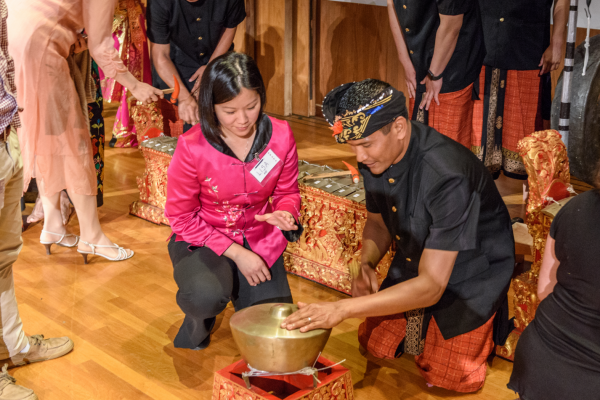Lisa Ng is pictured with I Ketut Sudiana, a musician with the Balinese Gamelan and Dance Group, demonstrating how to play the Ketuk at NIST’s 2018 AAPI Heritage Month Celebration. Photo credit: Mike Gaitan.
Ed. note: This post is part of the Spotlight on Commerce series highlighting the contributions of Department of Commerce employees during Asian Pacific American Heritage Month.
Guest blog post by Lisa Ng, Mechanical Engineer, Indoor Air Quality and Ventilation Group, Engineering Laboratory, National Institute of Standards and Technology (NIST)
I immigrated to the United States with my parents when I was two years old. My father was a chef and my mother stayed at home with me (and my sister who was born three years later). They came to the United States from Taiwan where they did not know the language, they had no relatives, and they had little money. Neither of them finished elementary school. Growing up, my parents could not give me many material things. They could not help me with my schoolwork. But they taught me the importance of working hard, persevering, and that despite my ordinary upbringing, I could do extraordinary things.
I graduated from Upper Darby High School in Upper Darby, PA at the top of my class and received a scholarship that helped me stay out of debt while I attended Drexel University in Philadelphia, PA. I graduated with a B. S. in Civil, Architectural, and Environmental Engineering with honors and accepted a mechanical engineering consulting job in Taipei, Taiwan. While my offices were being renovated, and I was still required to work there, I began wondering about indoor air quality (IAQ) issues. Granted, I was being faced with them to the extreme (i.e., drywall dust covering my work surfaces with no outdoor air ventilation), but what was “normal” IAQ? Were we, as engineers, doing anything to ensure that building occupants were being exposed to “good” IAQ? All of the work I had been doing up to that point was making sure buildings were heated and cooled properly, but sitting in my dusty office, I realized that being a building mechanical engineer had to be more than just making sure the thermostat worked.
When I started applying to graduate school, I met my soon-to-be advisor Dr. Jin Wen. She recruited me onto her research team at Drexel University and my education in IAQ began. I learned that people can get sick from the buildings they’re in because they’re inside 90 percent of the day! I learned that poor IAQ can lead to health issues but also affect productivity! I also learned that organizations, like ASHRAE, develop standards so that acceptable IAQ can be maintained in buildings. Wow, buildings aren’t just static structures? No! They contain living breathing mechanical systems that can help occupants work more productively and live more comfortably.
It was then that Dr. Wen introduced me to Dr. Andrew Persily, now Division Chief of the Energy and Environment Division, Engineering Laboratory, at NIST. I thought I’d learned a lot in graduate school. Dr. Persily and my colleagues in his group had quite a bit more about IAQ to teach me. “Acceptable” IAQ is defined differently for everyone because we respond to contaminants differently. Standards are written so that buildings can be designed to have adequate IAQ, but are they operated as intended? Buildings are so complex, and IAQ is such a fascinating, expansive topic.
I have had the privilege to conduct research in IAQ and ventilation at NIST since I joined as a post-doctoral research fellow in 2010 and as a full-time staff member in 2011. Being a career civil servant in an area of research that affects the health of every single person in America (i.e., air inside an office, air inside your home) every day is humbling. The fact that my research seeks to ultimately serve the public’s well-being is what motivates me and excites me to come to work every day. It is exhilarating to work with colleagues who are just as passionate about their research and the impact they have on American lives.
The commitment that NIST researchers have to their work is also demonstrated in the months leading up to Asian American Pacific Islander (AAPI) Heritage Month in May. For the past six months, the Association of NIST Asian Pacific Americans (ANAPA) has been hard at work creating and executing two events at NIST: “A Historical Re-enactment of Heart Mountain” and “Taste of Asia”. On May 6th, over 10 NISTers, members and non-members of ANAPA, re-enacted the trial of Japanese-Internment draft resisters who refused induction into the U. S. Army during WWII unless their civil rights were restored. On May 20th, NISTers contributed and served homemade dishes at the Taste of Asia so that we could celebrate the diversity and culinary culture of Asian food with the wider NIST community.
It has been rewarding to see the AAPI celebrations at NIST grow from three tables at the Taste of Asia to now 30 tables! As NIST researcher Dr. Dat Duthinh, director of “A Historical Re-enactment of Heart Mountain," pointed out: While we have enjoyed hosting cultural groups such as the Balinese Gamelan and Dance Group in 2018 (pictured here), such performances have often highlighted our differences and focused on the “Asian Pacific” part of our group’s name. This year, with the remembrance of Heart Mountain, we are giving attention to the “American” part of our group’s name.
Aren’t we all both different and the same as all of our fellow Americans? Our differences make us unique, but let us use our similarities to unite us.


